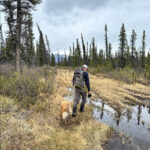Gnats are a common nuisance, especially when they appear to swarm unexpectedly. These tiny, winged insects often provoke a common question: “Is A Gnat A Baby Fly?” The simple answer, and a crucial point to understand, is no, a gnat is not a baby fly. In fact, what we commonly call “gnats” are adult insects, not immature stages of larger flies.
What Exactly is a Gnat? Understanding Gnat Identity
The term “gnat” is a broad, informal label applied to many types of small, two-winged flies. It’s not a scientifically precise term, which contributes to the confusion. These insects, despite their diminutive size, are fully developed adults, capable of reproduction. Thinking of them as “baby flies” is a misconception. The tiny size might mislead some, but it’s essential to recognize that gnats are simply small species of flies, much like there are small and large breeds of dogs. Common culprits often mislabeled as gnats include fruit flies and fungus gnats, each being distinct adult insects in their own right.
Gnat Characteristics: What Do Gnats Look Like?
Gnats, in general, are characterized by their small size and slender bodies. They typically have long legs relative to their body size, which can sometimes make them appear delicate or even ungainly fliers. Indeed, gnats are often weak fliers, which is why you might see them hovering or drifting rather than making strong, direct flights. Their size is a defining feature, often being just a few millimeters in length.
Gnat Behavior and Diet: Debunking the “Baby” Idea
Adult gnats exhibit a range of behaviors and feeding habits depending on their specific species. Some species play beneficial roles as plant pollinators, contributing to the ecosystem by transferring pollen from flower to flower. Others are predatory, feeding on crop pests like aphids and scale insects, thus acting as natural pest control agents. Conversely, some gnats are considered pests themselves, such as the Hessian fly which can damage crops. Dietary habits are equally varied; gnats may feed on plants, other insects, or even blood, with some species being biting and others non-biting. A fascinating behavior in some gnat species is their mating ritual where males gather in large swarms, often described as “ghosts,” particularly at dusk in open areas. All these complex behaviors are those of adult insects, further reinforcing that gnats are far from being baby flies.
Gnat Life Cycle: From Egg to Adult – No Baby Fly Stage in Sight
Like all flies, gnats undergo complete metamorphosis, a life cycle with four distinct stages: egg, larva, pupa, and adult. Gnat eggs are laid in various environments, depending on the species, either on land or water. The larvae, once hatched, may be mobile in aquatic environments or remain relatively immobile in soil or decaying organic matter. It’s crucial to note that the adult stage is the final, reproductive stage – the stage we recognize as “gnats.” There is no “baby fly” stage in the sense of a juvenile form that will grow into a gnat. The larval and adult stages are considered to have both beneficial and detrimental impacts, depending on the species and context.
Preventing Gnat Problems: Targeting Adult Gnats and Larval Sources
Effective gnat control focuses on managing adult populations and disrupting their breeding cycle, not on eliminating a non-existent “baby fly” stage. For fungus gnats, a common indoor nuisance, the key control method is to address overly moist soil in potted plants. Allowing the soil to dry out completely between waterings will kill the larvae residing in the soil. Adult fungus gnats can be physically removed using a vacuum cleaner. For general gnat populations, especially those attracted to fruit, ensuring fruit is not left exposed is important. Storing fruit in the refrigerator not only protects it from gnats but also extends its freshness. Various traps, such as electric fly swatters or sticky traps utilizing UV light, can help manage adult gnat numbers, particularly indoors. However, these primarily target adult gnats and may not address the root of an infestation. For comprehensive gnat infestation treatment, including larval control, consulting a pest control professional is often the most effective approach.
Conclusion: Gnats Debunked – Adult Insects in Miniature Form
To reiterate, the idea of a gnat being a baby fly is a common misconception. Gnats are not juvenile forms of larger flies; they are simply small adult flies. Understanding this distinction is key to effectively dealing with gnat issues. By recognizing gnats as adult insects with their own life cycle and behaviors, we can implement targeted and effective control strategies, focusing on adult management and larval source reduction rather than chasing the myth of the “baby fly.”
More Information
- Are gnats attracted to light?
- Black Gnats
- Do gnats bite?
- Fungus Gnats
- Fungus Gnat Larvae
- Gnat Eggs
- Gnat Infestation
- Gnat Traps
- Fungus Gnat Life Cycle
- Gnats in Kitchen
- Gnats in Plants
- Gnats in Sinks
- Gnats in the Soil
- How long do gnats live?
- How to Get Rid of Gnats Outside
- What attracts gnats?
- Where do gnats come from?
- What do gnats eat?
- What do gnats look like?
- Where do gnats breed?
- Why do gnats fly in your face?
